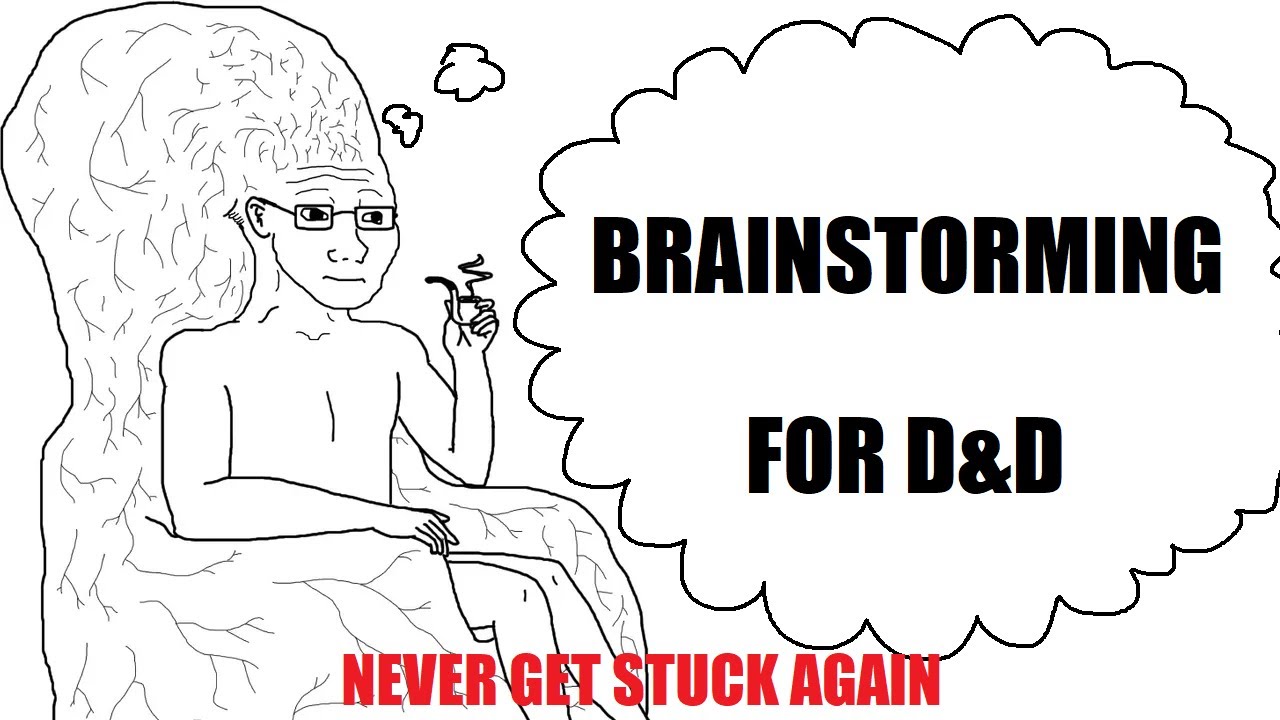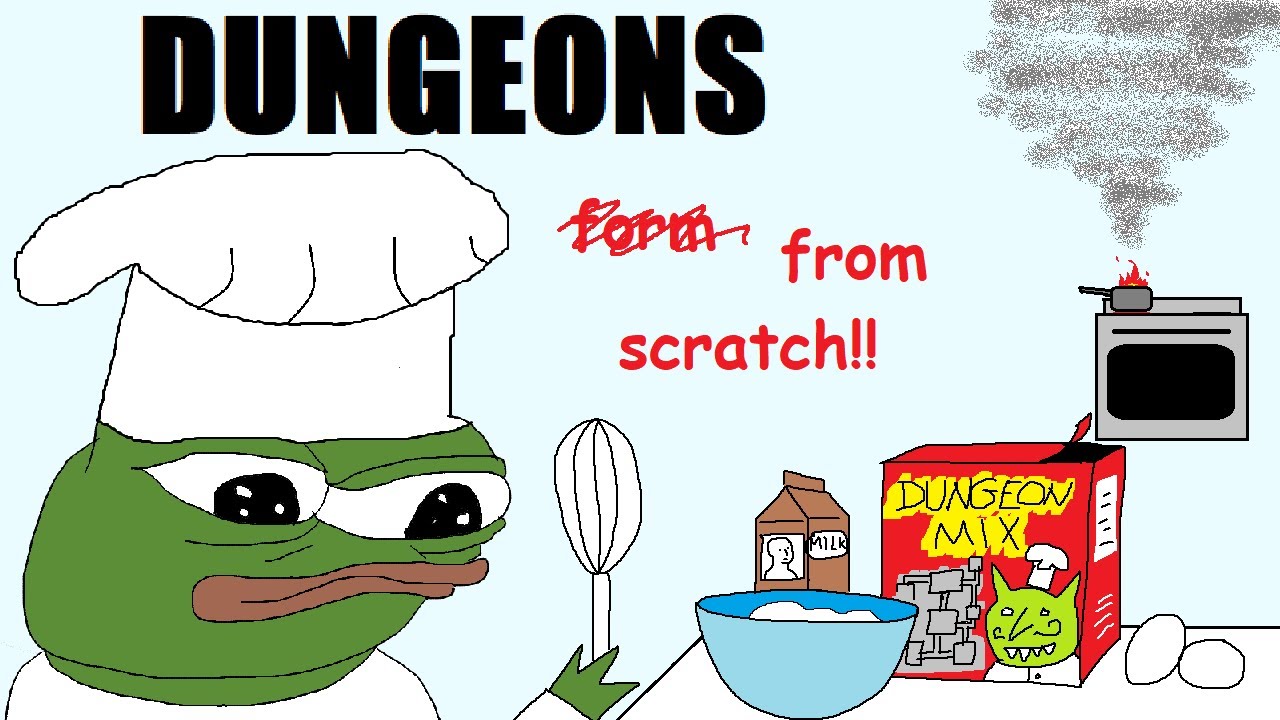Use this procedure when you want to detail a dungeon level from scratch or expand on existing material. If you want to create an entire dungeon, simply apply the procedure for each level.
Theme
You likely already have an idea for the level’s theme (e.g. ancient catacombs). If not, create one or elaborate from possible existing levels/locations (e.g. sunken temple in a swamp).
Detail your theme in 1-2 words.
Brainstorming the theme
Set a timer and start brainstorming:
For 5 minutes:
Write down anything (no self-censoring or correcting) that comes to mind when picturing the theme.
For 5 minutes:
Go over the list of stuff you came up with and write down the first thing that comes to mind for each entry.
Curate the list:
Clean up or tweak entries as you want, delete unusable entries, link possibly related entries.
Background
Answer the following question regarding the level with 1-2 sentences (if applicable):
• Where is it?
• Who created it?
• What was its original purpose?
• Who lives there now?
• Who is the primary power that resides here currently?
• Is its existence known?
• Is it accessible?
Environment
The default state of things, unless specified otherwise. Write 1-2 sentences each for the following:
• Space: What kind of space is it? (e.g. natural space like a cave, constructed space like a castle dungeon, open area like a forest, etc.)
• Structure: How high are the ceilings? What kind of doors/barriers exist?
• Lighting: Natural light, artificial light or is it completely dark?
• Senses: Sights, Sounds, Smell (anything that stands out?)
• Anything special/relevant (e.g. no ability to teleport into/out of the level or summon extra-planar creatures into it)
Lists
Draw from your ideas created during the brainstorming and create the following lists. Split up entries that encompass multiple lists appropriately (e.g. ghouls in a church => put the encounter and ghouls under Monsters/Encounters, and the church under Rooms/Locations, link them as related).
• Monsters/Encounters
• Traps/Dangers
• Rooms/Locations
• Special
• Treasures
• NPCs
• Factions (pulling from Monsters and NPCs as makes sense)
• Misc. (stuff that doesn't fit in any of the above)
Note on NPC and Monster distinction:
The line between the two is very fluid, as either can be the other, depending on the PCs’ approach (e.g. a dragon is likely to be a monster and an NPC). For simplicity, assume that NPCs are monsters that you want to name and have an idea for beyond just a simple encounter.
Feature Checklist
Check this list and add anything missing you want to include.
Exploration:
• Treasure: coins, gems, artworks, historical artifacts, trade goods, natural or harvestable resources, large hoards, treasure maps to treasure on the same level, a different level or outside the dungeon (not necessarily an actual map), unwieldy or large treasure, etc.
• Equipment: weapons, armor, general magic items, scrolls, potions, etc.
• Information
• Beneficial features (granting spells or skills, removing afflictions, etc.)
• Empty rooms
• Hidden rooms
• Areas of respite
Inhabitation:
• Monsters
• Encounters
• Lairs
• Ambushes
• Overwhelming encounters (requiring preparation, trickery, diplomacy or coming back stronger or smarter, e.g. a 12 HD dragon on level 2 of the dungeon)
• NPCs (friendly/beneficial, neutral, hostile, rival adventuring parties, merchants/traders, etc.)
• Factions (singular member, minor factions, major factions, sub-factions)
Interaction:
• Traps
• Secrets
• Things to interact and experiment with (e.g. altar, door, fountain, idol, mirror, mosaic, painting, pool, sarcophagus, statue, throne, well, etc.)
• Weird stuff
• Things or situations requiring preparation (e.g. water breathing for flooded sections, finding a lever/key deeper in the level to open a door, etc.)
Detailing the lists
Detail each entry in your lists with a sentence or two. Here are a few things you might want to consider for each list:
Monsters/Encounters:
• Rarity, power level (keep somewhat to the dungeon level's difficulty for common monsters), stats & abilities
• Consider relations between monsters (hierarchy/"food chain"/allegiances)
• Keep background and environment in mind with regard to monster types and placement
• Monsters should utilize the environment, e.g. archers on ledges, ogre kicking large table at frontline to knock them down, gargoyles pulling PCs off cliff
• Consider hints/clues for encounters, especially overwhelmingly dangerous ones
• Overwhelming encounters should probably be escapable
• Monster motivations should be easy enough to extract from their description or the encounter description, e.g. a spider on the ceiling is waiting for prey, ogres behind a barred door are guarding their lair, etc.
Traps/Dangers:
• Obvious vs hidden, natural vs constructed, mechanical vs magical
• Consider hints/clues for traps, especially very dangerous ones
• Usage by monsters/NPCs/factions
• Consider activation chances for mechanical traps
Rooms/Locations:
• Empty rooms should still be interesting, flavour according to environment or hint at background
• Corridors and hallways can be interesting, encounter areas or keyed
• Keep background in mind (e.g. if a cruel tyrant lives there, include a few hints to that, like tortured minions)
• Include hints to other rooms/locations, monsters, traps, secrets, interactions, etc.
Treasures:
• Consider background and environment for flavour (e.g. mineable gems in a mine, expensive books in a library, etc.)
• Include hints/clues for hidden treasure
NPCs:
• Personality, goals, attitude, treasure and what they offer (consider faction allegiance/relations, relations to other NPCs or to the level itself (e.g. old resident vs newcomer)
• Keep background and environment in mind regarding what types can be encountered
• Don't assume that NPCs won't be fought, so give them stats and don't overly describe them
• The "challenge" of NPCs can be calibrated via personality, power and strangeness, e.g. a mad man wielding a wand of disintegration intent on building his own little kingdom is harder to safely interact with than an emaciated prisoner that simply wants to return home
Factions:
• Goals, activities, means/power, treasure and what they offer
• Lairs, roster (order of battle) and defensive measures for lairs
• Attitude and tactics for patrols (e.g. run and get reinforcements)
• Retaliatory tactics
Mapping
Drawing from your detailed lists and what was established via environment and background, start creating a rough draft of the level’s map. For each location/room placed, note the content.
Either create the room concept first, then draw the map (e.g. the room will be a cathedral, so the map will be based off that) or the other way around, as preferred.
Create a treasure plan. Large hoards and magic items should be placed first, then the rest is stocked up to reach the treasure total for the level.
Treasure total: (fighter level = dungeon level) * 4 + some extra (~25%) to account for missed treasure.
Start with predetermined lairs, monsters and treasure hoards. Keep the following ratios in mind for populating the map (create extra content as necessary), adjust them as befits the level (e.g. a tomb will probably be more sparsely populated than an active lair):
• Monsters 33% (50% chance of guarding treasure)
• Traps 16% (30% chance of trapped treasure)
• Empty Rooms 33% (15% chance of hidden treasure)
• Specials 16%
• 10% chance for double feature (Monster & Trap, Monster & Special, Trap & Special)
Map chunks of rooms and distinct locations, then connect them as makes sense. Connect rooms conceptually (e.g. if you have two things that fit in a temple, make them part of the same temple).
Consider loops, interconnections, connections to the outside and other levels, verticality (3D-ness), interactivity, interesting room designs and so on.
Optionally, put traps, secret doors and other important features on the map (maybe even locations of keyed encounters/set monsters).
Don’t finalize the map yet, as it will likely change still.
Keying
Start numbering at the primary entrance, then go left-right, top-bottom. Room complexes should have numbers close to each other. Give each room a name and detail the key to the necessary detail level.
Description order:
1. Immediately observable/obvious things
2. Encounter details (monsters/NPCs, activity, shortened stats, etc.)
3. Interactable things
4. Hidden things
Common or constant details can be handled via room complex or area description. Indicate which rooms are part of what complex (e.g. Complex B => Rooms B12, B13, etc.)
Wandering Monsters & Random Encounters
Create a roster of your keyed encounters for which it makes sense to wander the level. Optionally detail area ranges for wandering monsters (e.g. cultists are only encountered in the temple area). Remember to cross an encounter off the list/remove it from the keyed room if it is dealt with.
Draw from the roster and create a table of wandering monsters. Add random encounters to the table, consisting of possible monsters encountered on this level and adjoining ones (depending on the connection state)
A few things to consider:
• Mix monster types as makes sense (e.g. goblins riding on worgs)
• Include a chance for rolling twice on the table (double encounter)
• Sometimes it makes sense to create a sub-table for an entry, e.g. for the make-up of a faction patrol
• Include NPCs and events
• Include a brief activity for each encounter, usually one word is enough (e.g. hunting, will stalk party, looking for treasure, etc.)
• The table should expand as new dynamic elements are added (restocking, faction activities, level connections opening up, etc.)
Remember that keyed encounters should react to anything happening close by that draws attention, like fights or loud noises.
Dynamic Elements
To keep the level interesting and dynamic even after the PCs have grown beyond it, the following things can be added:
• Event that happen at predetermined times or when conditions are met (e.g. the sealed lich-beast is released, by players or otherwise, and is added to the encounter table)
• Procedural events, e.g. weather table indicates monsoon season, so parts of the level get flooded
• Faction “growth” or decline, faction activity (e.g. after 5 months, the cultists are reinforced by an anti-paladin, who starts attracting chaotic followers)
• New things show up (see below)
Restocking
Create a table of possible monsters and things that could show up on the level. Most likely includes most of the encounter table. Add some new monsters and monster types. Possibly include new treasure as XP for new characters in case of deaths or TPKs. Customize the two things below as befits the level.
Basic restock procedure:
Roll 1d6. 1 = Monster, 2 = Monster (Treasure), 3-6 = Empty (1 in 6 chance of concealed treasure).
Basic restock conditions:
After the death of the most powerful monster or group of monsters on the level.
After all non-hidden rooms on the level have been explored.
Every 1d6 expeditions.
After extended time away from the level (~1 month).
What is known about the level & Rumors
Determine the chance that information is available about the level. The deeper the level, the more expensive and general the information is.
Rumors:
• Rumors can be about monsters, treasure, trap, NPCs, factions, locations, environment, background, etc.
• Include who or where the rumor was learned from.
• There can be multiple, different rumors about the same thing.
• Rumors should only rarely be completely false and if they are, they should still lead to something interesting.
• Optionally, create separate rumors from sources outside the dungeon and from sources inside the dungeon. “Insider” information is more detailed and less likely to be false.
Hooks
Create quests, missions and treasure maps for treasure, items, NPCs, paths to other dungeon levels, locations, knowledge, etc. on the level.
Finishing Touches
Finalize the map. Alternatively, detail other dungeon levels first, in case new connections or ideas come up.
Name the level!
Inspirations

